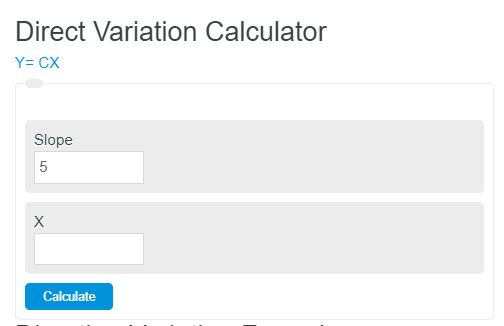Enter the constant of variation and x point along a line into the direct variation calculator. The calculator can calculate the X or Y value, or the constant of direct variation given 2 of the variables.
- Slope Calculator
- Parallel Line Calculator
- Perpendicular Line Calculator
- Coefficient of Variation Calculator
Direction Variation Formula
The following formula is used for calculating a direct variation.
C = X/Y
Y= CX
- Where C is the constant of direction variation
- X and Y are coordinate points.
To calculate the direction variation, divide X by Y of the reference line, then multiply the result by X of the target line.
In this case, the form y= cx is also the point-slope form of a line. Just as with the line form, a direct variation may have a constant b, associated with it.
Direct Variation Definition
A direct variation is defined as the relationship between two dependent variables. That is each variable is directly proportional to the other variable at a constant rate.
How to calculate direct variation?
How to calculate direct variation?
- First, determine the constant of direct variation.
This is C in the formula above. This variable is also often known as the slope when considering linear equations. For this example, the slope is 5.
- Next, determine one of the coordinate points of x or y.
Determine the value of one variable. For this problem, we know X coordinate to be 4.
- Finally, calculate the missing variable.
Using the formula above, calculate the missing variable using a direct variation. Y = 5*4 = 20.
Direct vs Indirect Variation
A direct variation, as is outlined above, is a situation in which a variable is directly proportional to some other variable via a constant.
This means that as one increases, the other will also increase and as one decreases, the other will also decrease.
Indirect variation, or sometimes referred to as inverse variation, is the relationship between two variables in which one is inversely proportional to the other.
This equation would look something like y=c* 1/x. In this situation, as y increases, x decreases and vise versa.
FAQ
A direction variation is a relationship between two variables. Typically this is described in the form of a line equation like y=cx, where c is the direct variation constant.
Direction variation can be used in any situation that involves one or more variables. For example, if you have two variables A and B that are directly related, then you can figure out their values at any point in time. Let’s say for every point A increase B increase 2 points. This means that if A=4 then B =8.

